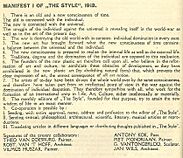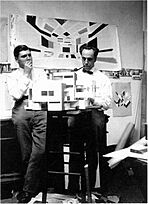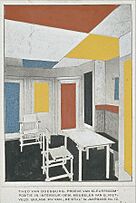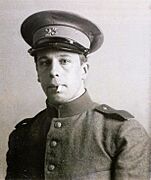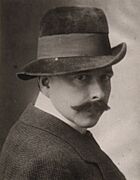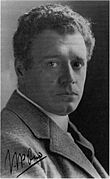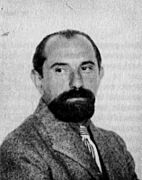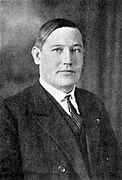De Stijl facts for kids

Theo van Doesburg, Composition VII (the three graces), 1917
|
|
| Years active | 1917–1931 |
|---|---|
| Country | The Netherlands |
| Major figures | Theo van Doesburg, Piet Mondrian, Gerrit Rietveld, J.J.P. Oud, Bart van der Leck |
| Influences | |
| Influenced | |
De Stijl (which means "The Style" in Dutch) was a Dutch art movement. It started in 1917 in Leiden, The Netherlands. This group included artists and architects.
The artists of De Stijl wanted to create very simple, pure abstract art. They believed in showing universal ideas. To do this, they used only the most basic shapes and colors. Their artworks often featured only vertical and horizontal lines. They used only black, white, and the three primary colors: red, yellow, and blue.
De Stijl was also the name of a magazine. The Dutch painter and writer Theo van Doesburg published it. This magazine helped spread the group's ideas. Key members included painters Piet Mondrian, Vilmos Huszár, and Bart van der Leck. Architects like Gerrit Rietveld and J. J. P. Oud were also important. The main idea behind their art was called Neoplasticism. This means "the new plastic art."
Van Doesburg said that De Stijl was a reaction against other art styles of the time.
Contents
What were the main ideas of De Stijl?
The artists of De Stijl aimed for extreme simplicity. They used only straight horizontal and vertical lines. They also used only rectangular shapes. Their main colors were red, yellow, and blue. They also used black, white, and grey.
Piet Mondrian explained the rules of Neoplasticism. He wrote that this new art would ignore natural shapes and colors. Instead, it would use abstract forms and colors. This meant only straight lines and clear primary colors. So, his art used only primary colors and non-colors (black, white, grey). It also used only squares, rectangles, and straight lines.
De Stijl art often avoided perfect symmetry. Instead, it found balance by placing elements in opposition. This created a strong, yet balanced, look.
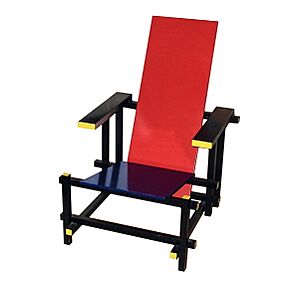
In many De Stijl artworks, especially 3D ones, lines and planes are layered. They don't always cross each other. This allows each part to stand out on its own. You can see this in the famous Red and Blue Chair and the Rietveld Schröder House.
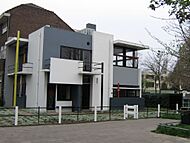
De Stijl was influenced by Cubist painting. It also took ideas from philosophy about "ideal" geometric shapes. The movement later influenced the Bauhaus style and the International Style of architecture. It also affected clothing and interior design.
In music, De Stijl influenced composer Jakob van Domselaer. He was a friend of Mondrian. His music aimed to balance "horizontal" and "vertical" musical parts.
How did De Stijl start?
The beginning of the movement
After World War I began in 1914, Dutch artists could not travel easily. This meant they were cut off from the international art world, especially Paris. Paris was the center of art at that time.
During this period, Theo van Doesburg wanted to start a new art movement. He was a writer, poet, and art critic. He was good at meeting new people and had many connections in the art world.
Founding of the De Stijl magazine

Around 1915, Van Doesburg began meeting artists who would form the group. He met Piet Mondrian at an art show. Mondrian had been visiting the Netherlands when the war started. He couldn't go back to Paris. He met other artists like Bart van der Leck there.
In 1917, these artists, along with poet Antony Kok, founded De Stijl. The young architect Gerrit Rietveld joined in 1918. At its peak, De Stijl had about 100 members. The magazine sold 300 copies.
In the early years, the group was very united. They published manifestos, which are public statements of their beliefs. Everyone signed these. The social and economic conditions of the time inspired their ideas.
Mondrian first used the term Nieuwe Beelding (Neo-Plasticism) in 1917. He wrote a series of articles about it in the De Stijl magazine.
Changes after 1920
Around 1921, the group started to change. Van Doesburg began working with the Bauhaus school in Germany. This brought new ideas, like those from Russian Constructivism. Not all members agreed with these new influences.
In 1924, Mondrian left the group. This happened after Van Doesburg suggested a new idea called "elementarism." This idea said that diagonal lines were more important than horizontal and vertical ones. This went against Mondrian's core beliefs.
After Van Doesburg's death

Theo van Doesburg died in 1931. He was a very important leader for De Stijl. Because of his central role, the group did not continue after his death.
The individual members stayed in touch, but De Stijl as a group ended. It's interesting to note that Mondrian and Rietveld, two key members, never actually met in person.
Many artists continued to use De Stijl's ideas in their work. Rietveld kept designing furniture based on its principles. Mondrian continued his abstract style. However, some artists, like Van der Leck, went back to more realistic art.

Influence on buildings
De Stijl had a big impact on architecture. Mies van der Rohe, a famous architect, was influenced by its ideas. The Rietveld Schröder House is the only building fully designed using De Stijl principles. Other examples include parts of buildings by J.J.P. Oud in Rotterdam. The interior of the Aubette dance hall in Strasbourg also shows De Stijl's influence.
Where to see De Stijl art today?
You can find artworks by De Stijl members in museums worldwide. The Gemeentemuseum in The Hague has a large collection of Mondrian's work. Amsterdam's Stedelijk Museum shows many works by Rietveld and Van Doesburg. The Centraal Museum in Utrecht has the biggest Rietveld collection. It also owns the Rietveld Schröder House.
The movement even inspired the design of some modern subway stations in Moscow Metro, like Rumyantsevo and Salaryevo, which opened in 2016.
Who were the Neoplasticists?
Here are some of the artists and architects connected to De Stijl:
- Ilya Bolotowsky (1907–1981), painter and sculptor
- Burgoyne Diller (1906–1965), painter
- Theo van Doesburg (1883–1931), painter, designer, and writer; he helped start De Stijl
- Cornelis van Eesteren (1897–1981), architect
- Jean Gorin (1899–1981), painter, sculptor
- Robert van 't Hoff (1887–1979), architect
- Vilmos Huszár (1884–1960), painter
- Frederick John Kiesler (1890–1965), architect and artist
- Antony Kok (1882–1969), poet
- Bart van der Leck (1876–1958), painter
- Piet Mondrian (1872–1944), painter, also a co-founder of De Stijl
- Marlow Moss (1889–1958), painter
- J. J. P. Oud (1890–1963), architect
- Gerrit Rietveld (1888–1964), architect and designer
- Kurt Schwitters (1887–1948), painter, sculptor
- Georges Vantongerloo (1886–1965), sculptor
- Friedrich Vordemberge-Gildewart (1899–1962), painter
- Jan Wils (1891–1972), architect
See also



